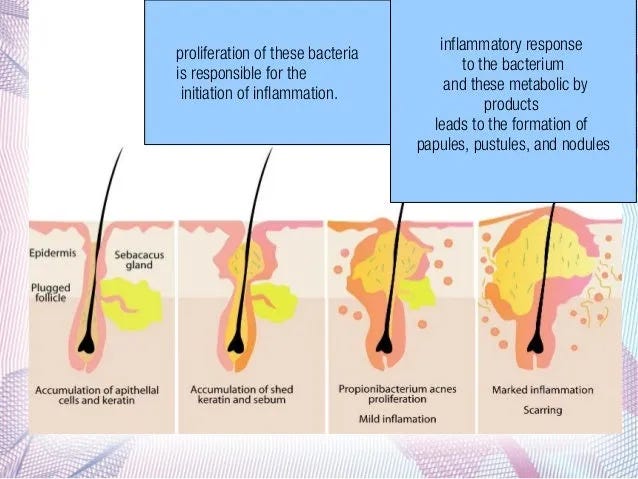I am so excited to talk about benzoyl peroxide today! Y’all - BP (aka BPO but I prefer BP) was my first real introduction to active ingredients in skincare years ago when I started trying to clear up my face. Interestingly, I had pretty clear skin for most of my life. It wasn’t until I started consuming meat and exercising (read: sweating) more that I started running into acne issues. At the time, I thought skincare was something for fancy people, and I am decidedly not a fancy person (broke and homeless, homage BowTiedBull). Learning to view treating my skin as an extension of health and subsequently becoming an attractive person led to me realizing the power of aesthetics. And now a few years later, I’m now a cartoon deer on the internet shaming y’all into not being ugly anymore! T’was written, huh?
Anyways, let’s get into it. This is benzoyl peroxide:
BP is an organic (read: the chemical structure includes carbon atoms) peroxide. “Benzoyl” refers to the benzene ring with double bonded oxygens you see on both ends of the compound. “Peroxide” refers to the single bond between oxygens you see in the middle. When BP is metabolized, free oxygen radicals are formed as follows:
Peroxides are used as bleaching agents, but in the context of skin, BP is an active ingredient used to kill bacteria - specifically propionibacterium acnes, or P. acnes. P. acnes is a strain of bacteria that exists across the body and with particular abundance in our sebaceous glands as it tolerates hypoxic (read: low oxygen) environments well. While it has a place in our skin’s microbiome, P. acnes is an opportunistic pathogen and can be responsible for acne vulgaris. At a high level, the mechanism essentially works as follows:
P. acnes lives in our pores -> pore fills with sebum and dead skin cells -> P. acnes thrives in in the hypoxic environment, feeds off our sebum, and proliferates -> immune system signals an inflammation response -> lesion develops
To get around this, you could try just washing your face with water after a heavy sweat session. Unfortunately, that was not enough for me, and I needed a stronger ingredient. Enter BP! The free oxygen radicals formed when BP is metabolized are toxic to microbes. This is why I say BP is bactericidal - it literally kills bacteria.
You’ll often see BP included in prescription formulations with retinoids or antibiotics. In fact, have you ever heard of Epiduo?
I remember seeing ads for this growing up. This is a topical medication that combines adapalene (a retinoid) and BP to pack a powerful punch against acne through two mechanisms: increasing cell turnover and killing acne-causing bacteria. Another common combination I’ve seen is clindamycin (stay tuned for my “So You’ve Been Prescribed…” series) and BP:
As clindamycin is an antibiotic that also targets P. acnes, the dual formulation can be particularly effective. Despite bactericidal properties, BP is not actually an antibiotic itself. It does not induce antibiotic resistance in the same way clindamycin might. So if you’re previously tried clindamycin alone and it doesn’t work for you, perhaps BP might.
Personally, I am not interested in dropping expeditious (homage BowTiedFighter) amounts of money on doctor’s visits and prescription medication unnecessarily, so I leverage BP from another source: cleansers. You’ll typically find BP over-the-counter in the following concentrations:
4%: My preference if using on face. BP is harsh and can be particularly irritating if you already have dry skin, but I’ve never had an issue at 4%
2.5%: This is what I would drop to if my face couldn’t handle 4%
10%: This is what I would use for body acne in place of traditional soap a few times per week
The brand you’re probably most familiar with is PanOxyl, but you can just get the generic if you’re so inclined. I buy the generic off Amazon because active ingredients are all the same and paying more for brand names is dumb*.
Fair warning: cleansers are often going to be more harsh than a prescription spot treatment! If using BP, I’d follow up with a moisturizer regardless if it’s present in your cleanser or a leave-on treatment (though you should be moisturizing anyways obvi). I never use my BP cleanser more than once per day and instead opt to alternate it with plain water or my gentle Vanicream cleanser depending on how my skin feels. Further, I prefer to time its usage around the sweatiest part of my day. BP can bleach fabric, so after the gym, I’ll wash my face with it and hop right in the shower afterwards so I don’t ruin my clothes. It can also sensitize your skin to the sun, so if you’re not already wearing facial SPF, you should consider it.
In closing, I’ll leave you with yet another friendly reminder that I am not the person to ask about root cause analysis. Yes, I am a holistic health maxi, and I do believe in analyzing the relationship between your diet and skin before testing other solutions. That being said, the concepts I write about in terms of skin are optimized for my diet, lifestyle, and skin type. As always, you’ll have to take this information and manage your own individual risk to decide what’s best for you.
That’s all for now! Happy skincare!
*Yeah I mostly wrote that line so I could use the image, sue me (jk, plz don’t)
Note: you can now book consultations with me! Check it out here or DM me on Twitter to book with ETH







